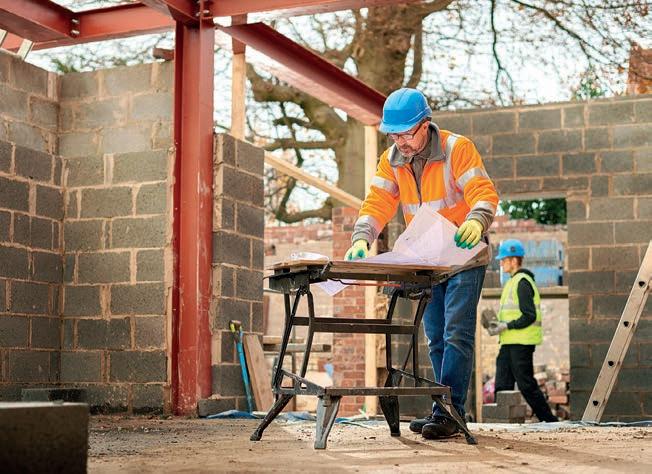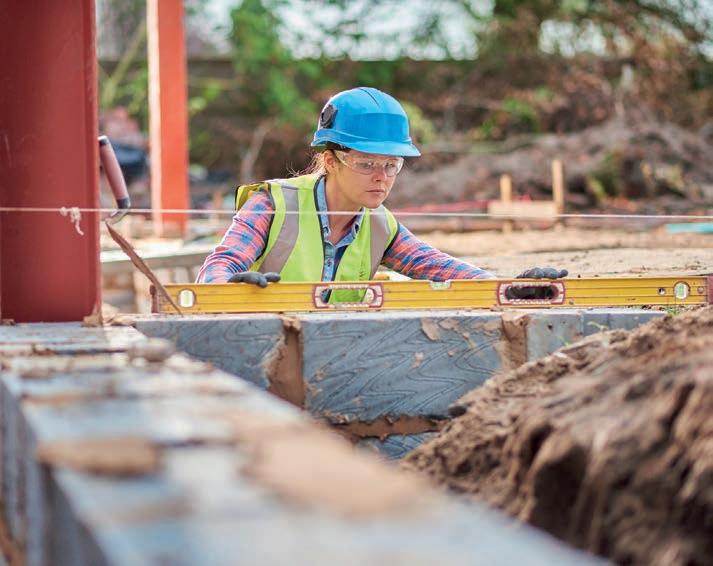
5 minute read
Skin deep
Despite the overwhelming focus on tackling the Coronavirus crisis and its economic impact, one issue has never left the minds of those who are sett ing the policy for the future of construction regulation and enforcement.
For more than three years, fi re safety has been an issue of paramount importance with many product manufacturers and building specifi ers continuing to develop and promote fi re safety initiatives.
Saint-Gobain Weber’s renders, decorative fi nishes and external wall insulation (EWI) products, for example, have been tested, retested and reviewed to assess fi re safety. Each variation has been put under scrutiny to understand its suitability for multiple building types and scenarios, not just in isolation but also in combinations and building systems most commonly found in the UK. But what does this tell us really? What do designers need to consider when reviewing the fi re safety claims being made by any product manufacturer today?
A warning bell about product marketing claims was rung by Dame Judith Hackitt in her 2018 review aft er the Grenfell Tower tragedy. She pointed out that the system for testing and certifying products for use in construction was “disjointed, confused, unhelpful, and lacks any sort of transparency”.
This baton was then picked up by the Marketing Integrity Group of the
Construction Products Association (CPA), which published research into the issue of product marketing. Since then the CPA has been developing a new voluntary code of conduct and a marketing trust scheme for building products, including proposals that all stated performance data for products must be referenced back to a dated test or a specifi ed desktop calculation. Where a test is referenced it must state the test, date passed, under what standard, where it was tested, by whom and how long the test is valid for. Most importantly, it is being proposed that the known limitations of a product must also be stated.
Is A2 classifi cation enough?
Most specifi ers will be familiar with the British Standard 476 fi re test series, which continue to be important. But today’s specifi cations also demand a good understanding of diff erent testing regimes, including the Euroclass classifi cations, which range from A1 (best) to F (worst). These gradings rely on products passing stringent European (EN) standards, which are diff erent from BS 476. The EN standard is based on tests for the materials and system’s response to fi re, smoke development and droplets while burning. In essence, the Euroclass system focuses on the overall combustibility of materials and contribution to fi re load.
Ever since additional building regulations guidance was issued in England at the end of 2018, which introduced a ban on the use of combustible materials in the external walls of high-risk residential buildings, there has been a steady presumption that a Euroclass A1 or A2 classifi cation is required for all façade materials. Or, more precisely, a presumption for dwellings over 18m in favour of either A1, which is basically completely non-combustible, or for A2-s1, d0, which describes products that are of limited combustibility and generate very litt le smoke development and no fl aming droplets or particles.
This A1 / A2 approach is still considered by many clients and specifi ers to design out
Lee Lambley, Technical Director at Weber, advises clients, architects, contractors and product specifi ers to look more closely now at the fi re safety performance claims of renders than they have in the past
risk and creates confi dence that a building will always comply to future building regulations. However, in some cases, this has led to an over-simplifi cation. It’s not enough just to look for an A2 classifi cation, it’s the information that sits behind this grading that matt ers most.
The Euroclass test relates to how a product reacts to fi re, but there are also essential BS tests regarding fi re resistance that look at integrity and load-bearing capacity, for example. Do you have all the test data, and if so to what standard was
that test carried out? Was the testing done by a UKAS-accredited test centre? Have you seen the actual test data or just gone from claims in the marketing literature?
Most specifi ers look at the classifi cation report summary and think “that’s my due diligence done”. But it’s nowhere near that simple. Product decisions should only be made on the basis of the full suite of documentation, including the complete set of individual test reports looking at the calorifi c value of the product, the way it responds to surface spread of fl ame and other aspects of performance. It’s imperative that specifi ers interrogate the evidence for renders and related external wall insulation ( EWI) systems, and all test evidence should be made openly available to all customers and published ideally available on the manufacturers website, particularly relating to products used on external façades.
One important check is to ensure that all the documentation matches up. The Euroclass certifi cation for a product should align with the individual test reports. The test reports should align with the Declaration of Performance (DoP). Another important check is the date of the test data, as it may be quite old – and chances are, the product may be materially diff erent now from that which was originally tested. Any change to a product’s formulation, no matt er how small, means that previous test data may be invalid and the product may need to be tested again.
What’s in a colour?
Perhaps surprisingly, one of the key issues in testing renders for fi re safety is the colour of the render. Historically manufacturers have only tested lighter colours, such as white or cream; not just because these are the most popular colours, but also because the amount of organic (and, therefore, combustible) content in these renders is less, and so they are more likely to pass a fi re test more easily. This is clearly not in the spirit of the Hackitt recommendations or the culture of product safety now required.
An appropriate range of colours should be tested separately with the support of the UKAS testing facility. Producers should have this assessment to cover their full colour range, especially reds, which contain the highest level of organic content. Greys and yellows can also throw up interesting test results that need careful checking.
If this all sounds complicated, it isn’t. It probably takes about half an hour to check product claims, and once you are familiar with what you’re looking at it’s not diffi cult to identify anomalies. Specifi ers and contractors should just keep asking questions and not take anything at face value. Any reputable product manufacturer will be happy to share all their test data openly and honestly.










